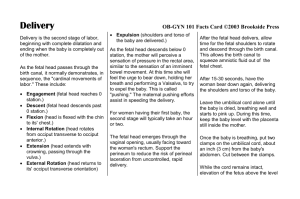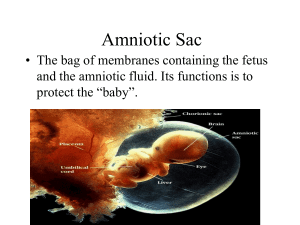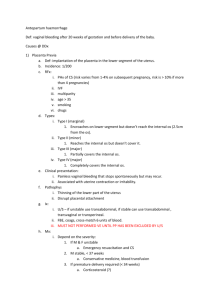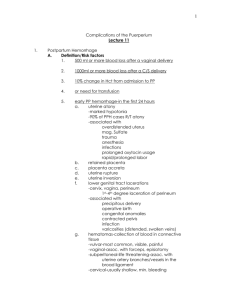Birthing your placenta
advertisement
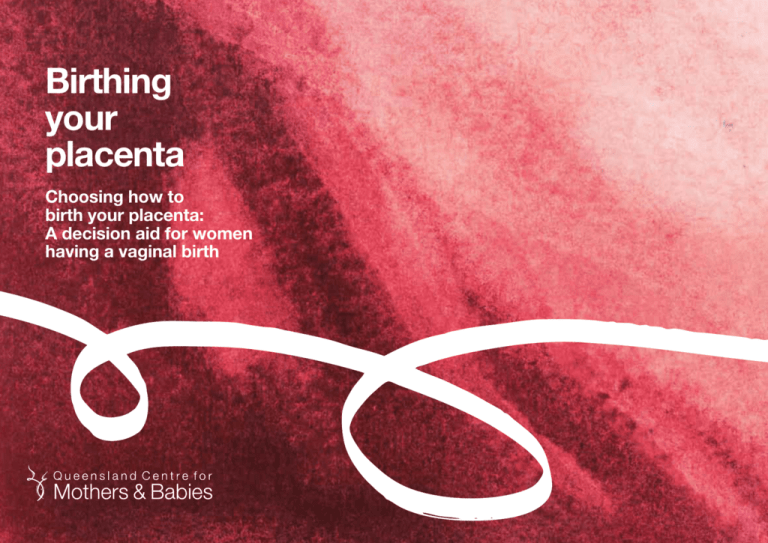
Birthing your placenta Choosing how to birth your placenta: A decision aid for women having a vaginal birth If you have any concerns about yourself or your baby/babies and want to talk to someone, please call: . »» your family doctor »» 13 HEALTH telephone line (13 432 584) »» Lifeline counselling service (131 114) »» Stillbirth and Neonatal Death Support (SANDS) helpline (1800 228 655) »» Pregnancy, Birth & Baby Helpline (1800 882 436) The research and development of this decision aid was conducted by Aimée Dane, a health psychology researcher at the Queensland Centre for Mothers & Babies. The Centre is an independent research centre based at The University of Queensland and funded by Queensland Health. The Centre does not stand to gain or lose anything by the choices you make after reading this decision aid. This What is this decision aid about? This decision aid has been written to support women who have a vaginal birth to know what to expect and to have a say in making decisions about the third stage of labour. The third stage of labour (or just the third stage) is the time from when a woman births her baby to when she births her placenta (or the afterbirth). decision aid has been developed to be consistent with International Patient Decision Aid Standards criteria for quality decision aids whereever possible. This decision aid provides information about two options: This decision aid is not meant to give you medical advice or recommend a course of treatment and you should not rely on it to provide 1. Choose to have a physiological third stage of labour 2. Choose to have an actively managed third stage of labour you with a recommended course of treatment. It is not intended and should not be used to replace the advice or care provided by your midwife, your doctor and/or your obstetrician. You should consult and discuss your treatment options with your midwife, your doctor and/ or your obstetrician before making any treatment decisions. This decision aid will answer the following questions: The University of Queensland, its employees and affiliates have made reasonable efforts to ensure the content provided is up to date »» What is the placenta and what is third stage of labour? »» How can I be cared for during the third stage? »» What happens if I choose a physiological third stage? »» What happens if I choose an actively managed third stage? »» How might cord clamping and cutting affect my baby? decision aid may be reproduced or copied in any way without the prior written permission of The University of Queensland. »» What happens if my placenta doesn’t birth? Last updated: »» Will I always be able to choose? »» How might I choose between physiological third stage and actively managed third stage? »» What are the differences between having a physiological third stage and having an actively managed third stage? »» How can I make the decision that’s best for me? »» How can I ask questions to get more information? and accurate. However, it does not guarantee and accepts no liability or responsibility for the accuracy, currency or completeness of the information contained in this decision aid. To the extent permitted by law, The University of Queensland its employees and affiliates exclude all liability including negligence for any injury, loss or damage caused by or arising out of any reliance on the content contained in this decision aid. Unless otherwise indicated, the content of this decision aid is the property of The University of Queensland. All content is protected by Australian copyright law and, by virtue of international treaties, equivalent copyright laws in other countries. No material contained within this November 2012 ©2012 The University of Queensland, Brisbane Australia. ABN 63942912 684, CRICOS provider No. 00025B What do the symbols mean? The information in this decision aid has come from the best scientific studies available to us. Numbers in brackets [1] indicate a reference to a study that is listed at the back of the decsion aid. We use this symbol e-Version 1.4 when there is something you might like to ask your care provider about. 2 What is the placenta and what is the third stage of labour? The third stage of labour (or just ‘the third stage’) is the time from when a woman births her baby to when she births her placenta. The placenta is an organ that connects to the wall of a pregnant woman’s uterus (womb). The baby is connected to the placenta by the umbilical cord. The umbilical cord allows nutrients (eg vitamins and minerals) and oxygen from the woman to travel to her baby. After a woman births her baby, she also births her placenta. The contractions (tightening of the uterus) a woman has during her labour and birth continue after her baby is born and help her birth the placenta. These contractions also help to stop any bleeding from the uterus that a woman may have. The length of the third stage is different for every woman. For some this stage can last for less than 30 minutes, for others it can last over an hour [2]. When your baby is born, he or she will still be attached to the placenta by the umbilical cord. For some women, their baby’s umbilical cord will be clamped and cut. The umbilical cord is clamped and cut to separate the baby from the placenta. Some women choose not to clamp or cut the umbilical cord and wait for the cord and placenta to detach a few days after the birth. This is called a lotus birth. It is normal for a woman to have bleeding from her uterus during the third stage. Sometimes, a woman has a postpartum haemorrhage (or PPH). A postpartum haemorrhage is when a woman has more bleeding than usual. A postpartum haemorrhage usually happens if a woman’s uterus doesn’t contract enough during the third stage. Usually, a postpartum haemorrhage is defined as losing more than 500ml of blood [2]. To give you an idea of how much this is, when you donate blood around 600ml to 750ml is usually taken [3]. When a woman has a postpartum haemorrhage, her care provider will usually offer her drugs to help stop the bleeding. Placenta Umbilical Cord Amniotic Fluid Uterus Amniotic Sac Cervix Bladder Vagina Labia Anus Perineum Some things may make a woman more likely to have a postpartum haemorrhage, such as being pregnant with more than one baby. You might like to ask your care provider about the things that increase a woman’s chance of having a postpartum haemorrhage. 3 How can I be cared for during the third stage? There are two options for how you can be cared for during the third stage: Option 1 Choose a physiological third stage Option 2 Choose an actively managed third stage Photo courtesy of Deirdrie Cullen 4 Option 1 What happens if I choose a physiological third stage? A physiological third stage is when a woman relies on her own production of oxytocin (a natural hormone produced during labour and birth) to birth her placenta. Oxytocin makes a woman’s uterus continue contracting after her baby is born and helps her placenta separate from her uterus. Oxytocin also helps to stop any bleeding from a woman’s uterus and can prevent a postpartum haemorrhage. In a physiological third stage, the woman is not given Syntocinon® (a drug that has been made to copy oxytocin as closely as possible). In a physiological third stage, you and your care provider wait for the placenta to detach from the inside wall of the uterus and move down the birth canal (the passage from the uterus that leads down through the vagina). While you wait, you might be kneeling or standing, or you might sit on a special stool called a birth stool. Most women hold their baby and/or have skin-to-skin contact (having your baby against your chest, without any clothing in between) and/or put their baby to their breast during the third stage. Studies have shown that skin-to-skin contact and breastfeeding increase the production of oxytocin in a woman’s body [4-6]. The production of oxytocin helps the placenta to birth by causing the uterus to contract. If you would like skin-to-skin contact with your baby, you might like to ask your care provider that this happens immediately after birth. What are the best conditions for a physiological third stage? It has been suggested that the best conditions for a physiological third stage are when [1]: »» »» »» »» »» »» »» »» »» »» a woman feels she is in a safe, calm and supportive environment, and a woman’s care provider is experienced and skilled at a physiological third stage, and a woman’s labour and birth proceed without drugs, and a woman and her baby are healthy after the second stage of labour (the birth of the baby), and a woman has immediate and continued skin-to-skin contact after birth, and a woman and her baby are kept warm, and a woman’s baby starts breastfeeding, and a woman is in an upright position during the birth of her placenta, eg kneeling, standing or sitting on a birth stool, and a woman’s placenta is birthed with gravity and pushing only, and a woman’s uterus is not massaged (this is done by massaging the abdomen), and controlled cord traction is not used (gently pulling down on the umbilical cord to help birth the placenta). Once the placenta has detached from the uterus and is moving down the birth canal, your care provider might suggest that you try to push the placenta out. After the placenta has been birthed, your care provider will usually check your uterus to see that there are no placental membranes (parts of the placenta) still in your uterus, and that you are not bleeding more than expected. Some cultures have different ways of birthing the placenta. You might like to talk to your care provider about what options there are for women with special cultural needs. Sometimes, unexpectedly, you or your baby may need extra medical care during birth or just as the third stage is about to start. For example, a woman may have excessive bleeding or her baby may need help breathing. If you have chosen to have a physiological third stage and an unexpected emergency occurs, your care provider may suggest that you have an actively managed third stage or that you be given Syntocinon® to help your uterus to contract. You might like to discuss these issues with your care provider. 5 Option 2 What happens if I choose an actively managed third stage? An actively managed third stage is when a woman is given Syntocinon® to help her birth the placenta. Syntocinon® makes the uterus continue contracting after the baby is born. Syntocinon® also helps to stop any bleeding from a woman’s uterus and helps prevent a postpartum haemorrhage. Syntometrine® is another drug that is an artificial form of oxytocin. Syntometrine® is slightly different to Syntocinon® and is usually used only if a woman is thought to have a higher chance of a postpartum haemorrhage or if Syntocinon® has not worked. If you choose an actively managed third stage, your care provider will give you Syntocinon® soon after the birth of your baby. Syntocinon® will usually be given through an intravenous (IV) drip (which is a bag of liquid that enters your body through a needle in your hand or arm) or as an injection into your leg. Syntocinon® usually causes a contraction of the uterus within a few minutes. Some women hold their baby and/or have skin-to-skin contact and/or put their baby to the breast during the third stage. If you would like skin-to-skin contact with your baby, you might like to ask your care provider that this happens immediately after birth. Finally, your care provider will usually help ease the placenta out of your vagina. After this, your care provider will usually massage your uterus by massaging your abdomen, to make sure it has contracted well. Your care provider will usually also check your uterus to see that there are no placental membranes still in your uterus and that you are not bleeding more than expected. Sometimes, unexpectedly, you or your baby may need extra medical care just as the third stage is about to start. You might like to discuss with your care provider what might happen if an unexpected emergency occurs during the third stage and what your options are if this happens. Some things, like receiving drugs to start off labour or to manage labour pain, as well as the occurrence of unexpected emergencies, are thought to reduce how much oxytocin a woman naturally produces during and after birth. You might like to ask your care provider about the things that can affect how much natural oxytocin you produce. After your baby’s umbilical cord has been clamped and cut, your care provider will do controlled cord traction. Controlled cord traction is when your care provider holds the umbilical cord and gently pulls down on it, while pushing on the uterus with their hand (outside your body). A small amount of bleeding from a woman’s uterus at this time is common. 6 How might cord clamping and cutting affect my baby? What happens if my placenta doesn’t birth? Early or delayed cord clamping describes the time between the birth of the baby and the clamping and cutting of the baby’s umbilical cord. Generally, if you choose a physiological third stage your care provider will do delayed cord clamping. Delayed cord clamping is when your baby’s umbilical cord is left unclamped for more than one minute or until cord pulsation has ceased. Cord pulsation occurs when the blood is in the placenta is allowed to travel back to the baby. If you choose to have an actively managed stage, you can choose whether your baby has early or delayed cord clamping. Early cord clamping is when the umbilical cord is clamped and cut within one minute of birth. Sometimes a woman takes longer than usual to birth her placenta. If you haven’t birthed your placenta within a certain amount of time, your care provider may offer you Syntocinon®, if you have not already been given it. The amount of time before you are offered Syntocinon® is different for different care providers, so you might like to ask your care provider what they usually do. If your placenta is still not birthed after some time, your care provider may offer to remove your placenta manually. Removing the placenta manually is when your care provider uses his or her hand to gently scrape away the placenta from the uterus, through your vagina. Sometimes there are times when the placenta is removed through an incision (cut) in your abdomen. You might like to ask your care provider about why manual removal may be used. For more information and support about the decision to have early or delayed cord clamping for an actively managed third stage, please see the decision aid ‘Choices about clamping your baby’s umbilical cord: A decision aid for women having a vaginal birth.’ Photo courtesy of Little Posers Photography 7 Will I always be able to choose? How might I choose between a physiological and actively managed third stage? Most hospitals in Queensland will do an actively managed third stage unless a physiological third stage is requested. If you plan to have your baby in a hospital, you might like to discuss your preferences for the third stage with your care provider during pregnancy. A number of studies have looked at what happens when women have a physiological compared to when women have an actively managed third stage. We have included some of the results of these studies in the next few pages. Most births at home or in a birth centre will do a physiological third stage unless an actively managed third stage is requested. If you plan to have your baby at home or in a birth centre, you might like to discuss your preferences for the third stage with your care provider. Will the results of these studies apply to me? Different care providers care for women having a physiological or actively managed third stage in different ways. There might also be guidelines at your planned place of birth for how women are cared for if they choose a physiological or actively managed third stage. You might like to ask your care provider about how he or she usually cares for a woman having a physiological or actively managed third stage and if there are guidelines at your planned place of birth. The studies we’ve included are studies of women who were described as low risk (eg women who were thought to have a low chance of a postpartum haemorrhage). However, every woman’s pregnancy is different, so the possible outcomes of each option might be different for you. You might like to talk to your care provider who can give you extra information that is suited to your unique pregnancy. Some of the studies we talk about are better quality than others. Whenever we talk about the results of a study, we give you some idea of the quality, using the following rating: In some situations, your care provider might suggest one option instead of the other. If this happens, you can ask your care provider about the reasons for their suggestion and make decisions as a team. If one option is suggested by your care provider instead of another, you can choose to follow their suggestion or choose to say no. Some care providers choose not to offer, or are not comfortable offering, all options to women. If you are not offered all options, or the option you prefer, you can ask to have another care provider. is given to studies that are high quality. level studies tell us we can be very confident that choosing to do something causes something else to happen. studies are the very highest quality of studies. is given to studies that are medium quality. level studies can tell us we can be moderately confident that choosing to do something causes something else to happen. is given to studies that are low quality. level studies can tell us when things tend to happen at the same time. But level studies can’t tell us that choosing to do something causes something else to happen. In the next few pages we talk a lot about the chance of different things happening. If you would like help understanding what this means, please visit www.havingababy.org.au/chance 8 What are the differences between having a physiological third stage and having an actively managed third stage? Studies have found there is a difference between having a physiological and having an actively managed third stage of labour in: Women who had a physiological third stage… Women who had an actively managed third stage… The average amount of blood lost [3] Women lost on average 286ml of blood Women lost on average 209ml of blood The chance of having high blood pressure between the birth of the baby and discharge from the labour ward [3] 4 out of every 1000 women had high blood pressure in the hours after birth 28 out of every 1000 women had high blood pressure in the hours after birth The chance of having afterpains (pains from the 2 out of every 100 women had afterpains 5 out of every 100 women had afterpains 15 out of every 1000 women had a blood transfusion 4 out of every 1000 women had a blood transfusion uterus contracting after birth) [9] Women who had afterpains Women who did not have afterpains The chance of having a blood transfusion (being given blood) [3] 9 What are the differences between having a physiological third stage and having an actively managed third stage? Continued... Studies have found there is a difference between having a physiological and having an actively managed third stage of labour in: The chance of using pain management for soreness after birth [9] Women who had a physiological third stage… Women who had an actively managed third stage… 2 out of every 100 women used pain management for soreness after birth 5 out of every 100 women used pain management for soreness after birth 1 out of every 100 women returned to the hospital due to bleeding 3 out of every 100 women returned to the hospital due to bleeding 3 out of every 100 women had a postpartum haemorrhage 11 out of every 100 women had a postpartum haemorrhage Women who used pain management for soreness after birth Women who did not use pain management for soreness after birth The chance of returning to the hospital due to bleeding after going home [3] Women who returned to the hospital due to bleeding Women who did not return to the hospital due to bleeding Note: This is only if the best conditions for a physiological third stage are met (see page 5) The chance of having a postpartum haemorrhage (losing more than 500ml of blood) [1] Women who had a postpartum haemorrhage Women who did not have a postpartum haemorrhage 10 What are the differences between having a physiological third stage and having an actively managed third stage? Continued... Studies have found no difference between having a physiological and having an actively managed third stage in: The length of the third stage of labour [9] My Notes The chance of having manual removal of the placenta [3] The chance of vomiting after birth [3] The chance of the baby having jaundice (yellowing of the skin and eyes) that is treated [7] The chance of the baby going into the Neonatal Intensive Care Unit ‘NICU’ (a unit in the hospital for babies who need a high level of special medical care) [7] The chance of having low iron levels within two days of birth [8] The chance of having treatment for vaginal bleeding up to 6 weeks after birth [3] Studies are not clear about whether there is any difference between having a physiological and having an actively managed third stage in: The chance of having low iron levels immediately after birth [3] The chance of having a more serious postpartum haemorrhage (losing more than 1000ml of blood) [3] [10] 11 How can I make the decision that’s best for me? At the Queensland Centre for Mothers & Babies, we understand that the right decision for you may not be the right decision for others. When making decisions about their maternity care, some women prefer to get the information and make decisions by themselves or with their families. Other women like to make decisions as a team with their care providers and some women like their care providers to make decisions for them. This decision is yours to make. You might change your mind about previous decisions if you get more information, if your circumstances change or your preferences change. For all decisions before, during and after your birth, you are entitled to know your different options, know what happens if you choose different options and choose the option that is best for you. Following these steps might help you to make the decisions that are best for you: Think about the reasons for choosing each option Think about which reasons matter to you the most When making a decision about which option is best for you, it can be helpful to think about the reasons that you personally might choose each option. We have included a table in this decision aid where you can write down both the reasons you might and might not choose each option. You might have come up with your own ideas or have found information somewhere else. Some reasons might matter more to you than others and you might want to give these reasons extra thought when making a decision. There is room in this decision aid for you to mark how much each reason matters to you in a box. Doing this can also help you talk to other people about what matters to you. You might like to use a simple star rating like this to mark how important each reason is: Matters to me a little Think about whether you’re leaning towards one option or the other Matters to me quite a bit Matters to me a lot Once you’ve thought about the reasons for choosing each option and how much each reason matters to you, you might feel that one option is better for you. Or, you might still be unsure and want to think about it some more or ask questions. There is a place to mark what you feel about your options within this decision aid. You can also show this table to your care provider to help you make decisions as a team. 12 How can I make the decision that’s best for me? Reasons I might choose to have a physiological third stage... Reasons I might choose to have an actively managed third stage… At the moment, I am leaning towards… A physiological third stage I’m unsure An actively managed third stage 13 How can I ask questions to get more information? Asking your care provider questions can help you get the information you want and need. Below are some questions you might want to ask your care provider to get more information during your pregnancy: How often do you care for a woman having a physiological third stage? How do you care for a woman having a physiological third stage? How often do you care for a woman having an actively managed third stage? How do you care for a woman having an actively managed third stage? What are my options if I would like a care provider who is experienced and skilled at caring for a woman having a physiological third stage? Are there guidelines at my planned place of birth about how women having a physiological third stage are cared for? Are there guidelines at my planned place of birth about how women having an actively managed third stage are cared for? How would you feel if I refused a physiological third stage if it was offered to me? How would you feel if I refused an actively managed third stage if it was offered to me? Do I have a higher chance of having a postpartum haemorrhage? Why or why not? What are the possible outcomes in my unique pregnancy of having a physiological third stage? What are the possible outcomes in my unique pregnancy of having an actively managed third stage? How might my chance of having a postpartum haemorrhage change during my pregnancy and labour? Are there things I can do during my pregnancy to decrease my chance of having a postpartum haemorrhage? My Notes 14 Where did this information come from? [1] Fahy, K.M., et al., Holistic physiological care compared with active management of the third stage of labour for women at low risk of postpartum haemorrhage: A cohort study. Women and Birth, in press. [2] National Collaborating Centre for Women's and Children's Health, Intrapartum care: Care of healthy women and their babies during childbirth. September 2007. [3] Begley, C.M., et al., Active versus expectant management for women in the third stage of labour. Cochrane Database of Systematic Reviews: Issue 11. Art. No.: CD007412. DOI: 10.1002/14651858.CD007412.pub3, 2011. [4] Matthiesen, A., et al., Postpartum maternal oxytocin release by newborns: Effects of infant hand massage and sucking. Birth, 2001. 28(1): p.13-19. [5] Nissen, E., et al., Elevation of oxytocin levels early post partum in women. Acta Obstetricia et Gynecologica Scandinavica, 1995. 74(7): p. 530-533. [6] McNeilly, A.S., et al., Release of oxytocin and prolactin in response to suckling. British Medical Journal, 1983. 286(6361): p. 257-259. [7] Rogers, J., et al., Active versus expectant management of third stage of labour: the Hinchingbrooke randomised controlled trial. The Lancet,1998. 351(9104): p. 693-699. [8] Thilaganathan, B., et al., Management of the 3rd stage of labor in women at low-risk of postpartum hemorrhage. European Journal of Obstetrics Gynecology and Reproductive Biology, 1993. 48(1): p. 19-22. [9] Begley, C. M. A comparison of ‘active’ and ‘physiological’ management of the third stage of labour. Midwifery, 1990. 6(1): p 3-17. [10] Davis, D., et al., Risk of severe postpartum hemorrhage in low-risk childbearing women in New Zealand: Exploring the effect of place of birth and comparing third stage management of labor. Birth: Issues in Perinatal Care, 2012. 39(2): p. 98-105. 15 15 My questions and notes 16 Acknowledgements Other decision aids • Choosing your model of care The Queensland Centre for Mothers & Babies would also like to acknowledge the families in Queensland for their generosity in contributing many of the beautiful photos contained in these decision aids. We would also like to thank the following organisations and individuals for their contribution to the development of this decision aid, or other decision aids we’ve developed. • Choices about first semester ultrasound scans • Choosing how to birth your baby: for women without a previous caesarean section • Choosing how to birth your baby: for women with a previous caesarean section • Choosing how you labour will start • Monitoring your baby during labour • Choosing your positions during labour and birth • Choices about epidural • Choices about episiotomy • Using a bath or pool during first stage labour • Choices about clamping your baby’s umbilical cord Organisations Australian College of Midwives (ACM) Caboolture Hospital Central Maternity & Neonatal Clinical Network Ethnic Communities Council of Queensland Friends of the Birth Centre Queensland Association Inc General Practice Queensland Griffith University Individuals Maternity Coalition Maternity Unit, Primary, Community and Extended Care Branch, Queensland Health Midwives Information & Resource Service (MIDIRS), UK Midwifery Advisory Committee, Office of the Chief Nursing Officer, Queensland Health Midwifery Advisor, Queensland Health Northern Queensland Maternity & Neonatal Clinical Network Herston Multimedia Unit Mater Mothers’ Hospital Preventative Health, Queensland Health Queensland Maternal and Perinatal Quality Council Royal Australian and New Zealand College of Obstetricians and Gynaecologists (RANZCOG) Redland Hospital Sexual Health and HIV Service Southern Queensland Maternity & Neonatal Clinical Network Statewide Maternity & Neonatal Clinical Network Stillbirth and Neonatal Death Support (SANDS) Network The University of Queensland Lana Bell Dr Wendy Brodribb Deirdrie Cullen Rachel Ford Dr Glenn Gardener Professor Geoffrey Mitchell Rosalie Potter Dr Camille Raynes-Greenow Assoc. Professor Allison Shorten Hayley Thompson Assoc. Professor Lyndal Trevena Queensland Centre for Mothers & Babies The University of Queensland Brisbane, QLD 4072 Australia www.havingababy.org.au info@havingababy.org.au 17

